 Go
to the Archive index
Go
to the Archive indexBy its very nature, most cycle competition consists of seeing how fast or how far a cyclist can go. From the nineteenth century on, one of the ways of increasing a cyclist’s performance has been to pace him with another vehicle to lead him to greater efforts than he would make when unaccompanied.
Pedal-powered tandems, triplets, quads and even quints were used, as well as both electric- and pedal-powered motor bicycles which themselves gave way to specialised pacing motor cycles capable of running steadily at cycle speed—or just above—while giving a measure of wind protection to aid the rider. On the six-day tracks, the motos de stayer could be very specialised indeed with belt drive, no real brakes and four foot long handlebars sweeping back to enable the rider to sit upright.
On the road, these were unsuitable, of course, and normal motorcycles with low overall gear-ratios in order to run at cycle speed and rear rollers to fend off—harmlessly—the following cyclist were the norm. If tandems were used, a distance race would need several changes of pacing crew, necessary but expensive.
In May 1936 ‘The Bicycle’ pictured a new ‘cyclo-moteur’ being tested at the Parc des Princes and early in 1938 a more developed version was under test by the organisers of France's longest paced race, the Bordeaux-Paris. In March 1938, 'Cycling' revealed the Derny machine in the form in which it was to be used into the 1970s on the race, also suggesting that Derny-paced racing at Brooklands would be a good idea. 'Cycling's' report on the 1938 race in the same month said:
“The real thing started at St. Maure and is a flying start as the pacers come into action. Special interest attached to the motor-pacing side of this famous event on the present occasion, from the employment of a new, standardised pacing machine, the ‘Derny’.
Riders picked up their pacing machines like lightning and the whole group got away down the hill from St. Maure at a terrific bat. The average speed shot up from 18½ mph to 37½ mph!
... the new motor-pacing regulations made for a much more sporting race than had been seen before in a Bordeaux-Paris!”
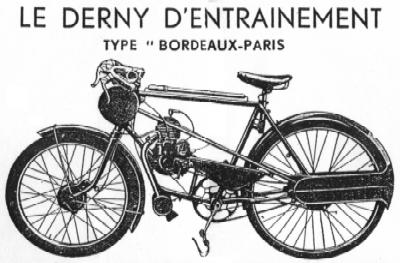
A success, then, from day one, the Derny was designed and made by Roger Derny and Sons (former racing cyclists themselves) at 81, Avenue St. Mande—later at Avenue du General Michel Bizot—both in Paris’s twelfth Arrondissement. It is basically a strong cycle frame of racing pattern with two extra frame members bowed outwards and linking steering head and saddle tube. The front fork on early models had an open twin-plate crown, later ones have a more normal cast one. A tubular mount rises from near the pedal assembly to support a Zurcher 98cc deflector-piston two-stroke single with an integral clutch and two-speed gearbox of antiquated design, the unit has a heavy outside flywheel rotating between the rider's knees and separate magneto ignition.
It is, however, a unit that pulls strongly at low revolutions enabling speed to be varied precisely ‘on the throttle’ without clutch slipping or very much gear changing. The fuel is contained in a drum-shaped tank—a Derny trademark—in front of the steering head and the pedal gear is fixed, the Derny rider having to pedal at all times.
The wheels of the Derny are of unequal size, the rear a now obsolete 28 inch. The rest of the machine’s equipment is standard for the period but the rider perches on a leather racing saddle fixed over that narrow rear tyre with predictably arduous results. It was not only the racing cyclists who found the Bordeaux-Paris hard work.
The exhaust silencer is also not particularly effective and the gearbox gears are ‘straight-cut’, as is the primary transmission. Both are only lubricated by oil mist, leading one French commentator to write that “the song of the Derny sawed at the ears of both its rider and the following cyclists”.
The Derny was made in relatively small numbers from 1938 to 1958 when the factory ceased production. The company later made more normal mopeds as well as motorised tandems but the entraineur or ‘Bordeaux - Paris’ was what the population identified as a Derny. It was perhaps made during WW2 as well since the Vichy government in France was very keen on sport as a way of occupying sections of the population.
Besides the Bordeaux-Paris race, on which about forty were needed each year, the Derny was used in innumerable professional races both on the road and on the track, where it rapidly became standard wear throughout Europe. The Criterium des As at Longchamp was another major French race to feature the sputtering little bikes, where the Derny replaced the more spectacular tandem pacers to the regret of many Parisians in the post-war period.
Just like the cyclists, the Derny pace-makers had their own dress code, as follows:
They were strictly forbidden to sit too upright on the bicycle, and race judges were expected to enforce this. At Chattellerault, the pick-up town for the Bordeaux-Paris, the pace-makers would wait until the advance motor cyclists of the peleton arrived and then “kick life into their mongrel mounts which bark out smoke way down the road At first sign of the riders, the principal pace-makers are on their way, cruising slowly along until their men make contact ... then the reserve pace-makers follow”.
No Derny had ever broken down on the race, said the company in its—very limited—advertising.
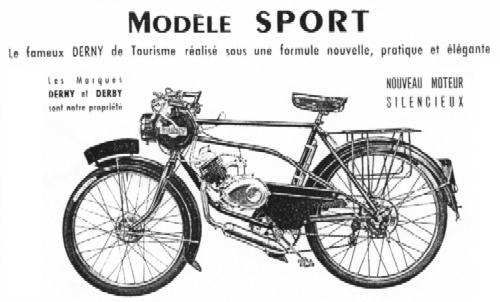
Post-war, the Derny company seems to have resumed production by 1948 at the same address. The Entraineur remained unchanged but was joined by a ‘Solo’ or ‘Tourist’ model with an inclined Zurcher engine, no extra saddle tube and a carrier instead of the large rear fender. This was a development of the 1939 touring model which was a lightly modified entraineur with free-wheel and carrier. The post-war solo models had a three-speed Cyclo derailleur.
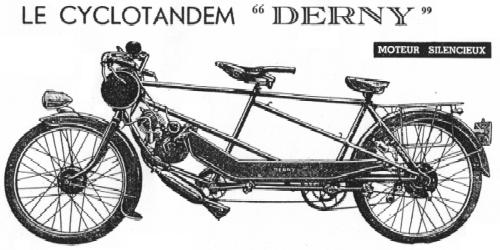
There was also a Tandem using the ‘Solo’ frame layout with an extra section behind for the ‘stoker’. All of these retained the trademark drum-type fuel tank and were given a large, fishtail style silencer instead of the twin pipes and transverse pot of the Entraineurs. The company also produced a version of the ‘Cyclorex’ (Buzzing, April 1990) in small numbers.
Extras included a leading-link front fork with Nieman rubber bands (identical to Excelsior autocycle) and a telescopic fork.
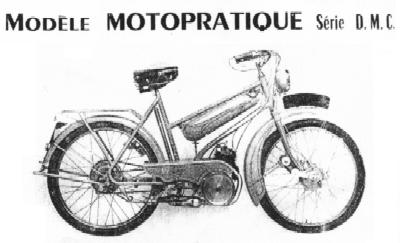
By 1951 the Zurcher engine with its outside flywheel was being displaced by a new 98cc unit with enclosed works, not unlike a Villiers 1F in appearance. A new autocycle of more conventional looks, the ‘Moto-Pratique’ arrived and by 1953 a small range of mopeds using SER and VAP engines of 65cc and 50cc respectively, as well as a ‘Tandem Grand Tourisme’, without the trademark tank. Sales, though, were still in penny numbers, the years 1950 to 1955 having totals of 1013, 976, 826, - , 904 and 1475.
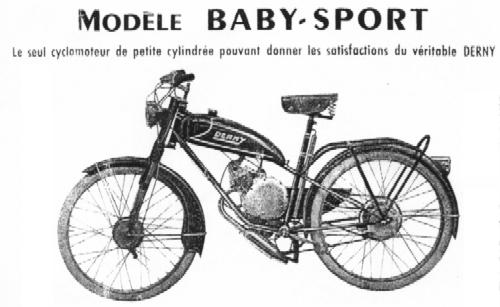
In 1956 an avant-garde motorcycle, the Taon, was launched but did not save the company, which closed its doors in 1958 after making perhaps 7000 machines. The market for a cycle-orientated ‘healthy-pedalling’ machine had gone.
If buying, be careful. Apart from the high prices asked, remember that ‘Derny’ is a generic word in France. Make sure that it is a ‘real’ Derny, if that is what you want, rather thin the later interpretations. Also, many tandems were cut down to solos and some entraineurs re-engined.
Dating is difficult with a machine that changed little. The type No DM1, DM3 etc) will be on the near side rear dropout. Later outside flywheel engines may or may not have a number. Sometimes the frame number is stamped on the engine chain-guard, normally quickly discarded. Few catalogues exist.
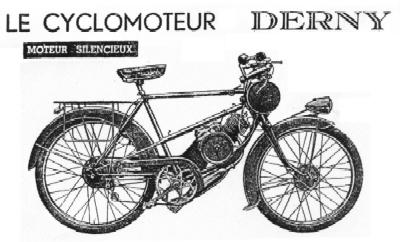
The Derny survived the closure of the parent factory, to run on in the Bordeaux-Paris until 1974, by which time the youngest of them was getting on for twenty years of age. They were maintained post 1957—and reconstructed, where necessary—by Service Derny of 88, rue Picpus, Paris, 19th Arrondissement.
Afterwards, a replacement ‘Derny’ called, officially a Burdin, was made with Mobylette power, and limited success. (All pacers are still called ‘Derny’, the noun given in the Larousse dictionary for a cycle-pacing moped). Surviving ‘Bordeaux-Paris’ models are now cherished collectors’ items.
Modern interpretations of the Derny are still made and used on the track, testifyng to the rightness of the design. The race which gave rise to the original, the Bordeaux-Paris, is no more.
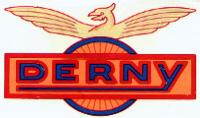
First published - August 2000